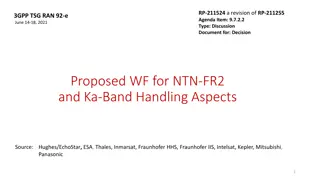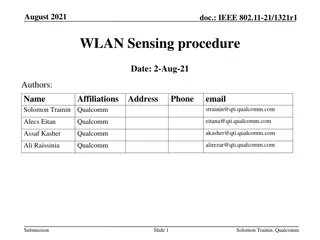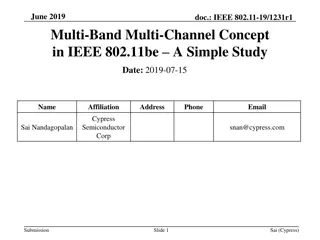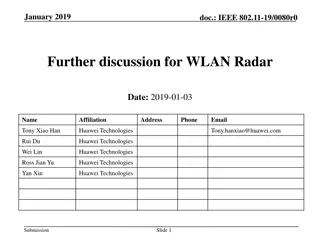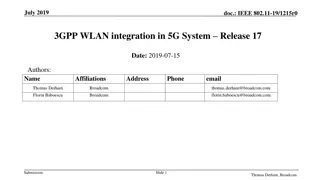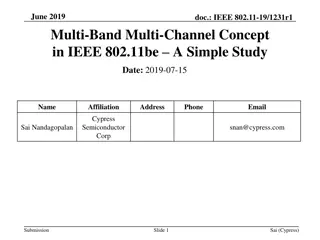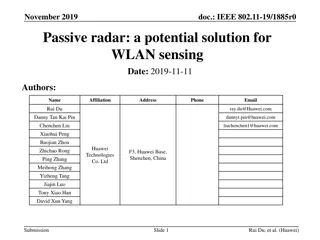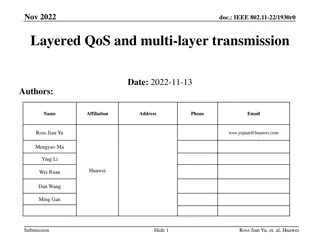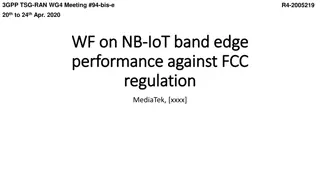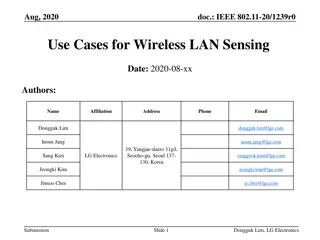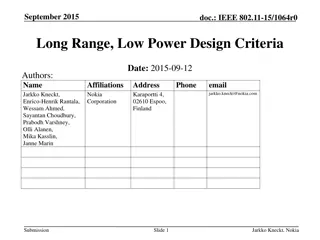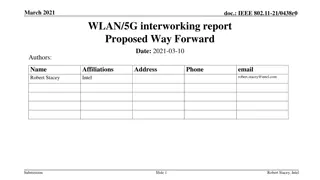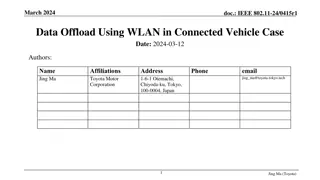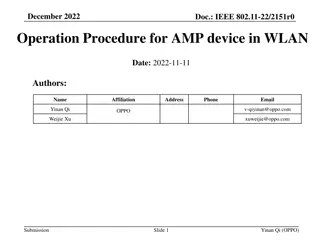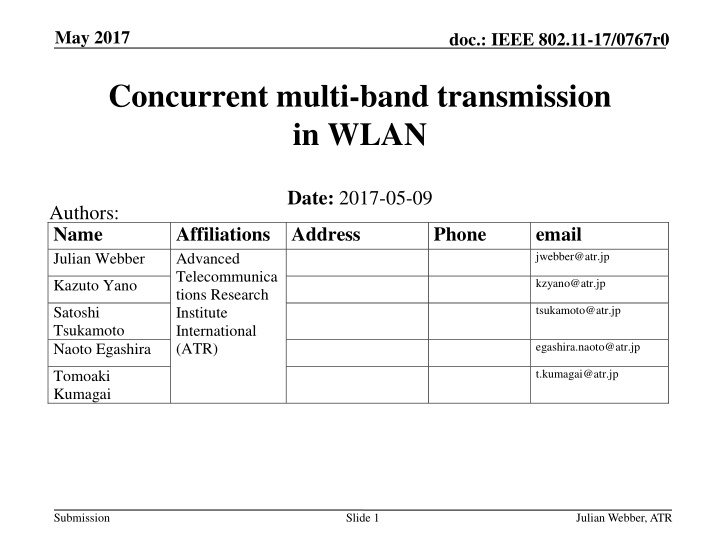
Enhancing Wireless LAN Through Multi-Band Transmission
Learn about the benefits of concurrent multi-band transmission in wireless LAN (WLAN) networks, such as increased bandwidth and improved Quality of Service (QoS). Discover various techniques to utilize multiple frequency bands simultaneously, including employing multi-band capable access points and exploiting idle channel periods for improved system throughput.
Download Presentation

Please find below an Image/Link to download the presentation.
The content on the website is provided AS IS for your information and personal use only. It may not be sold, licensed, or shared on other websites without obtaining consent from the author. If you encounter any issues during the download, it is possible that the publisher has removed the file from their server.
You are allowed to download the files provided on this website for personal or commercial use, subject to the condition that they are used lawfully. All files are the property of their respective owners.
The content on the website is provided AS IS for your information and personal use only. It may not be sold, licensed, or shared on other websites without obtaining consent from the author.
E N D
Presentation Transcript
May 2017 doc.: IEEE 802.11-17/0767r0 Concurrent multi-band transmission in WLAN Date: 2017-05-09 Authors: Name Julian Webber Affiliations Address Advanced Telecommunica tions Research Institute International (ATR) Phone email jwebber@atr.jp Kazuto Yano kzyano@atr.jp Satoshi Tsukamoto Naoto Egashira tsukamoto@atr.jp egashira.naoto@atr.jp Tomoaki Kumagai t.kumagai@atr.jp Submission Slide 1 Julian Webber, ATR
May 2017 doc.: IEEE 802.11-17/0767r0 Abstract Utilizing multiple frequency bands at the same time to concurrently transmit and receive data by a wireless node will increase the available bandwidth and improve the achievable QoS. This presentation describes several ways to utilize multiple bands : Multi-band capable AP with multiple independent transceivers Introducing concurrent multi-band technology to a STA Splitting data into either of available bands before queuing, taking into account the average channel condition Splitting data into either of available bands, based on instantaneous channel condition, after queuing Submission Slide 2 Julian Webber, ATR
May 2017 doc.: IEEE 802.11-17/0767r0 Background The amount of wireless LAN traffic is increasing every year. Forecasted amount of traffic will become four times larger from 2015 to 2020 [1]. Traffic offload to WLAN will increase to 63% of all mobile traffic, with forecasted mobile traffic increasing seven times from 2016 to 2021 [1]. Thus, enhancement of system throughput of the wireless LAN is still necessary. Growth of IP traffic forecasted by Cisco [1]. Submission Slide 3 Julian Webber, ATR
May 2017 doc.: IEEE 802.11-17/0767r0 Exploiting instantaneous channel idle periods 500 We conducted channel measurements at a main-line railway station in Japan to record the received signal strength of WLAN channels Example 500ms snapshot shows there are many short idle periods of which duration is typically 10-70 ms An agile receiver will have the potential to exploit idle periods in other channels or bands But to exploit the diversity, need to be able to switch channel sufficiently fast. 400 Time (ms) 300 200 100 0 1 6 108 116 112 (Left) 2.4 and (Right) 5 GHz Spectrogram (Channel numbers shown) Submission Slide 4 Julian Webber, ATR
May 2017 doc.: IEEE 802.11-17/0767r0 Multi-band capable APs with multiple transceivers A way to utilize multiple bands without fast switching of the band is to employ multiple transceivers having a different operating band. Multi-band capable AP have been available for around 10 years. The multi-band capable AP sets up a different BSS for each transceiver. Each STA joins one of the BSSs provided by the multi-band AP. If the STA chooses the joining BSS properly, the average QoS will be improved. However, each STA cannot utilize multiple bands simultaneously in this configuration. Upper MAC Band A Queue A Band A BSS A Lower MAC PHY (BB) STA1 RF Band B OS BSS B Lower MAC PHY (BB) RF Band B STA2 AP Queue B Upper MAC Submission Slide 5 Julian Webber, ATR
May 2017 doc.: IEEE 802.11-17/0767r0 Concurrent multi-band technology A STA needs to have a capability to utilize multiple bands if it wants to exploit the multi-band diversity. Concurrent multi-band is a technology for a wireless node to connect to two or more bands at the same time. It would be beneficial to enhance QoS achievable at a STA. Recently concurrent multi-band technology has been developed for smartphones and automotive use-cases. [2] The architectures of concurrent multi-band can be categorized into 2 types: - Type 1: Data is split into either of available bands before queuing - Type 2: Data is split into either of available bands, based on instantaneous channel condition, after queuing (Proposed idea) Multi-band wireless adapter Band A Band B STA AP Submission Slide 6 Julian Webber, ATR
May 2017 doc.: IEEE 802.11-17/0767r0 Type 1: Splitting before queuing Consider a STA connecting to an AP on two or more bands The queues in the Upper MAC on each band are totally independent Assume data of different applications are transmitted on different bands, taking into account the required QoS of each application and average channel condition Since the data cannot change the transmitted band after queuing, it would be difficult to adapt to the instantaneous change of channel, if the length of queue is long. Upper MAC Band A Queue A Lower MAC PHY (BB) From NW layer RF Splitter Band B Lower MAC PHY (BB) RF Queue B Submission Slide 7 Julian Webber, ATR
May 2017 doc.: IEEE 802.11-17/0767r0 Type 2: Splitting based on instantaneous channel condition after queuing (Proposed idea) Here we consider a wireless device having concurrent connections on two or more bands as in the previous slide. However, this configuration employs a common queue for all bands. The splitter directs each transmit data at the front of the queue to a particular band. Splitting decisions can now be controlled by real-time feedback of channel Busy-Idle status and/or channel state information. Upper MAC Band A Lower MAC PHY (BB) From NW layer RF Splitter Band B Lower MAC PHY (BB) RF Common Queue Lower MAC and BB Feedback Busy-Idle and CSI information Submission Slide 8 Julian Webber, ATR
May 2017 doc.: IEEE 802.11-17/0767r0 Type 2: Splitting based on instantaneous channel condition after queuing (Continued) Transmission latency will be reduced by the new approach if a STA can agilely exploit the real-time availability of idle periods. Splitting of data taking into account current channel state can be more appropriately matched with the required QoS or priority As the splitter is more sophisticated, QoS will be more improved. Julian Webber, ATR Submission Slide 9
May 2017 doc.: IEEE 802.11-17/0767r0 Summary This talk discussed features of concurrent multi-band technology to exploit multi-band diversity at a wireless node. If a STA has a capability to utilize multiple bands, the achievable QoS would be improved. In addition, if the transmitted data is split into available bands based on instantaneous channel condition, further QoS improvement would be achieved. Submission Slide 10 Julian Webber, ATR
May 2017 doc.: IEEE 802.11-17/0767r0 Straw Poll #1 Do you agree that a concurrent multi-band technology is beneficial to improve achievable QoS of wireless LAN? Y: N: Need more information: Submission Slide 11 Julian Webber, ATR
May 2017 doc.: IEEE 802.11-17/0767r0 Straw Poll #2 Do you think that a concurrent multi-band technology, with splitting the transmitted data into available bands based on instantaneous channel condition, is a promising approach as a way to further improve the QoS of wireless LAN? Y: N: Need more information: Submission Slide 12 Julian Webber, ATR
May 2017 doc.: IEEE 802.11-17/0767r0 References [1] Cisco, Cisco Visual Networking Index: Global Mobile Data Traffic Forecast Update, 2016 2021, Cisco White Paper C11-738429-00, March 2017. [2] BCM89359 - Single-Chip 5G WiFi IEEE 802.11ac 2x2 MAC/Baseband/Radio with Integrated Bluetooth 4.1/RSDB for Automotive Applications, Available at: http://www.cypress.com/documentation/datasheets/bc m89359-single-chip-5g-wifi-ieee-80211ac-2x2- macbasebandradio-integrated [Accessed May 2, 2017] Submission Slide 13 Julian Webber, ATR





